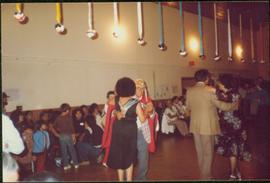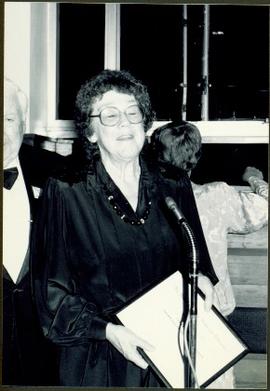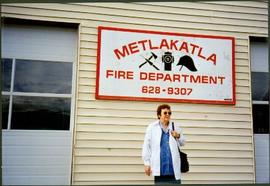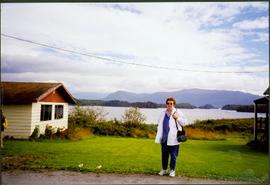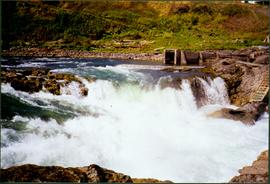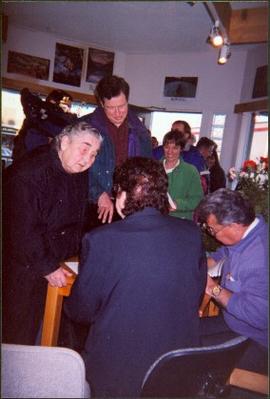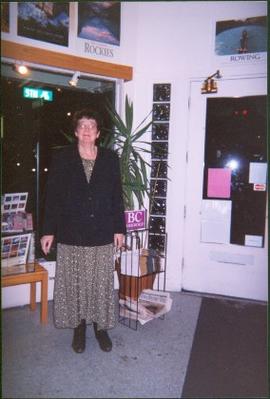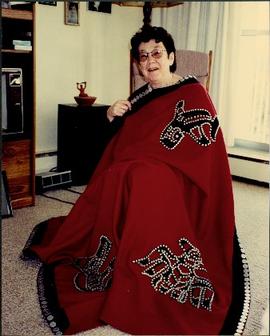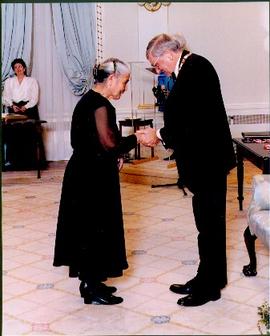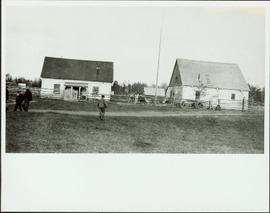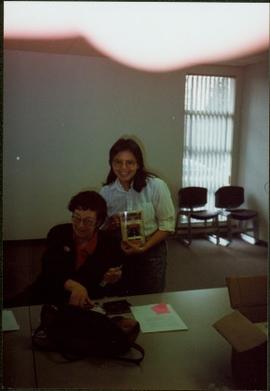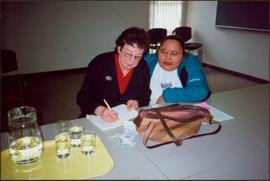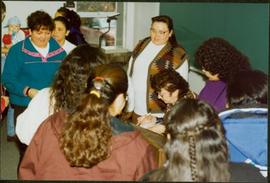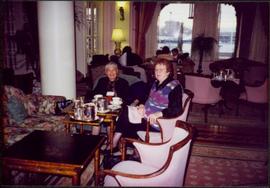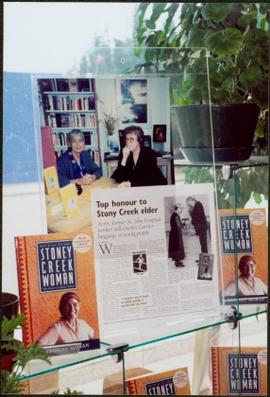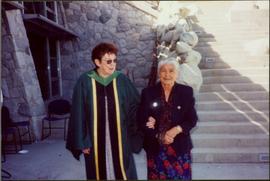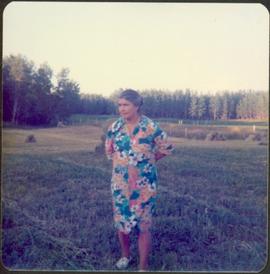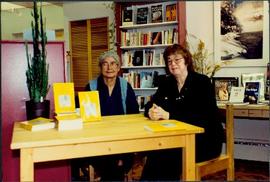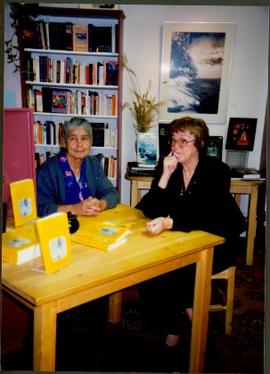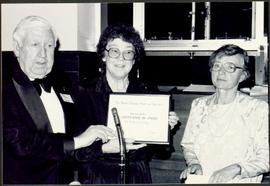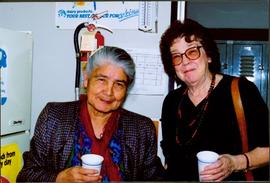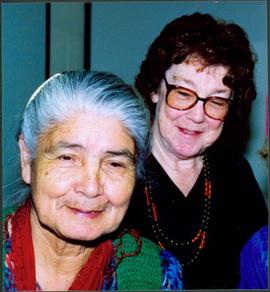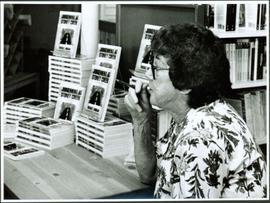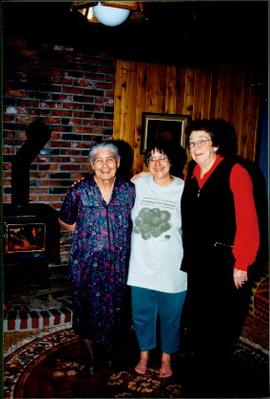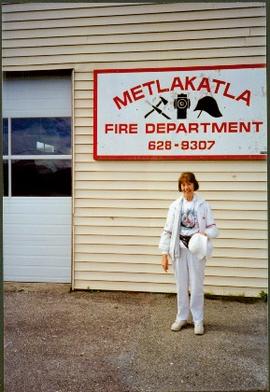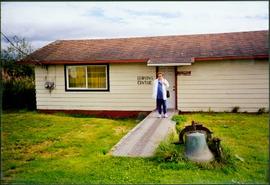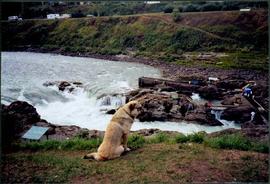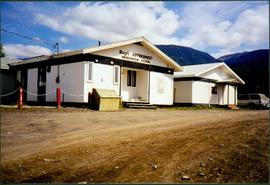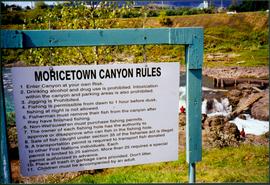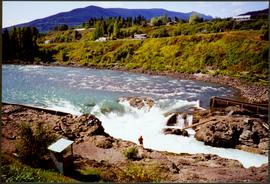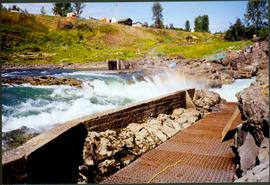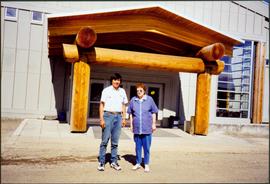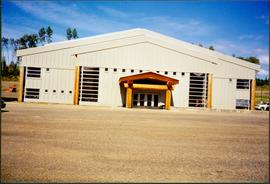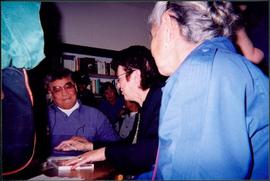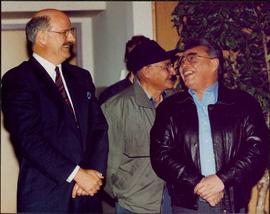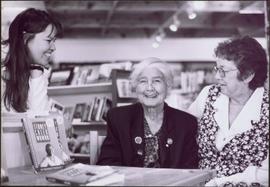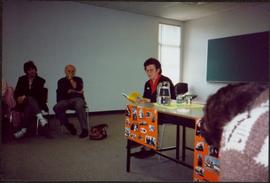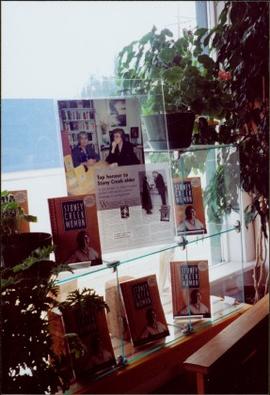Photograph depicts couples dancing in large room, crowd seated on chairs against wall in background. Ornaments are hung in a row from ceiling. Man dancing in centre wears traditional dress. Handwritten annotation on recto of photograph: "Elders gathering 1983".
Handwritten annotation on recto: "Bridget Moran thanks the B.C. Historical Federation for recognizing her as best author of 1988." Moran stands behind microphone, holding award. Don Sale and Naomi Miller of the B.C. Historical Federation Writing Competition Committee stand in background.
Moran stands in front of building with the sign "METLAKATLA FIRE DEPARTMENT 628-9307".
Bridget Moran stands on road, unidentified buildings behind on either side. Lake and hills on opposite shore in background. Photo believed to be taken at Metlakatla Lake, B.C. Building on left speculated to be the St. Paul's Anglican Church Learning Centre.
Photograph depicts white rapids at bottom of waterfall in Bulkley River, B.C. Fishing territory visible on far right; hill on opposite shore in background.
Photograph depicts Justa Monk and Bridget Moran seated at table, signing copies of 'Justa: a First Nations Leader'. The pair faces crowd standing in background. Windows and posters visible behind crowd.
Photograph depicts Moran standing in bookstore. Window, door, and plants in background. Photo taken at book signing event for Moran's 'Justa: a First Nations Leader'.
Photograph depicts Moran seated in chair at unknown location. Red and black button blanket features traditional thunderbird, wolf, and killer whale designs. Television, armchair, and window visible in background.
Photograph depicts Mary John shaking hands with unidentified man at official ceremony where she was awarded the Order of Canada for outstanding service to her community. Two unidentified woman stand in background in large ornately furnished room.
Photograph depicts two buildings behind fence, sheds visible in background. Unidentified men can be seen walking in foreground. Small structures believed to be teepees can be seen behind fence.
Photograph depicts unidentified woman holding copy of Moran's book, standing behind the author. Table in foreground, window and chairs in background.
Photograph depicts Moran seated to left of unidentified woman at table with glasses and pitcher of water. Window and chalkboard in background. (Woman also featured in item 2008.3.1.102.2).
Photograph depicts Moran seated amongst standing group of unidentified women. Overhead machine and chalkboard in background. Photograph was taken at session of Aboriginal Women's Training Program at the Cowichan Campus, Malaspina University College, in Duncan B.C.
Photograph depicts Mary John seated to left of Moran at table in large room with tables, chairs, and couches. Skyscraper and water visible through window in background. Accompanying note reads "Tea at the Empress! Feb/97"
Photograph depicts numerous copies of 'Stoney Creek Woman' (by Bridget Moran) in glass case. Display also features article on Mary John's receipt of the Order of Canada (see items 2008.3.1.22.61 and 2008.3.1.22.64 for photographs displayed in this image).
Item is a recorded audio interview with Justa Monk.
Audiocassette Summary
00’ 10” Continuation of Tape 2. Justa discusses the review of the Kemano project. He wants a public review where there is First Nations representation. He is frustrated by the lack of a working relationship and being recognized as a leader.
03’ 29” Their way of life is damaged from the flooding. Graveyards were flooded in the 1940s. Fishing grounds will never be the same. Kemano II will do the same damage to a narrower piece of land. Seven communities will be affected, particularly Stoney Creek, because there will be no more fishing grounds.
08’ 27” They are doing this for more electricity, not for the aluminum. BC Hydro made a deal with Alcan for a bigger reservoir. Moran asks Justa if BC Hydro is the ‘imp in the woodpile.’ Justa tells her there is a three-party agreement between Alcan, BC Hydro, and the provincial government. He tells her the project will not go ahead because he believes the Supreme Court will rule in their favour.
15’ 05” Moran mentions Mary John saying that everything the First Nations ‘ever got they had to fight for.’ They briefly discuss Oka. Justa returns to discussing the Kemano II project.
16’ 53” Moran asks Justa about the Aluminum Company of Canada.
17’ 49” They both talk about the Indian Agent that would not let First Nations people in his home. They both relay their disgust with a specific Indian Agent.
18’ 41” Moran asks Justa about the Carrier-Sekani land claims. He discusses having to revisit the boundary lines. Justa talks about an agreement he signed on September 21, 1992, where there would be proper representation for the First Nations people.
26’ 30” Justa discusses the ‘potlatch law’ which he describes as ‘love, share, and respect.’ He talks about how he often gets a good response from groups he teaches.
34’ 51” Moran tells Justa how she was contacted by the Stoney Creek Band regarding how they collected several stories that are unreadable. They have asked Moran to somehow transcribe them properly.
36’ 37” Moran asks Justa about the Kemano II decision from the Supreme Court. He talks about how he is disappointed in the decision, but said he expected it because the government has rarely ruled in favour of First Nations issues.
43’ 16” Justa tells Moran that he was written a letter to President Bill Clinton and Vice-President Al Gore extending an open invitation to see the damage the Kemano II project has done to the environment.
45’ 03” Moran asks Justa when he returned to Tachie to work. He discusses his work there. In 1969, he began work at BC Rail. He moved to Dawson Creek with Theresa and their family.
51’ 09” Moran asks Justa about returning to the village of Tachie, particularly with the trouble that had happened with his brother. He talks about how the elders believed that everything would work out and how many of his achievements relate to that philosophy.
54’ 37” Moran asks Justa about his maintenance work for BC Rail. He describes his position in detail.
59’ 44” Moran asks Justa about the great gardens his father had grown, but this has stopped because of the road. He talks about bringing in television to the community. He talks about when hydro came into the community in the early 1970s. He talks about the water and sewage system being implemented in the mid-1970s.
1:05’ 10” Justa talks about when he became band manager in 1973. He describes his position. Moran asks about the difference between band manager and chief. Justa describes the difference.
1:13’ 21” Moran asks about whether or not Justa had to deal with Indian Agents or the DIA during that time. He describes his band manager position further as being a marriage counsellor, policeman, secretary, a bouncer, and always trying to make peace within the community. He talks about the pressure of the position, and how it made his alcoholism worse, how he was on sleeping and nerve pills.
1:21’ 31” Moran asks about the population of Tachie. She asks about the location of Grand Rapids.
1:22’ 33” Justa talks about becoming chief in 1975, but also kept the band manager position. He discusses in detail about being both, particularly with social issues. He talks about how parties often ended up in some accident ie a little girl getting shot.
1:28’ 34” Moran asks about the isolation of the community. Justa discusses calling for a boat or a plane to evacuate someone in case of an emergency.
1:30’ 10” End of tape.
Item is a audio interview recorded by Bridget Moran with Justa Monk.
Audiocassette Summary
00’ 10” Moran asks about when the roads were built to Tachie. Justa talks about the length of time it took to get to work from Tachie to Portage before the roads were built. After some people drowned, the pressure was put on the Department of Indian Affairs to build a road. Justa talks about his trips before the road was built.
07’ 42” Moran asks about why Tachie was not built around Stuart Lake but at the mouth of the creek. Justa gives a brief history of Tachie.
09’ 20” Moran asks Justa about the history of his father, particularly what his jobs were.
11’ 01” Moran asks Justa what Camp 24 is, where his mother and father stayed at times. It was a camp owned by the Roman Catholic Church where people could stay while they worked in the bush. Justa says the camp was more of a settlement. Moran and Justa continue to talk about the living conditions of Camp 24.
16’ 47” Moran asks Justa about his father’s mother. Justa never met his grandmother, even though his father continued to visit her. They continue to talk about the history of Justa’s parents.
20’ 10” Moran tells Justa she has heard there are no more gardens in Tachie today. Justa tells Moran that people no longer live off the land and that is why the gardens no longer exist. Justa says he feels lucky that he was able to experience life by living off the land. Moran asks about how home brew is made. Justa gives a list of the ingredients and how it needed to sit for twenty-four hours before being able to drink it.
25’ 00” Moran asks Justa about what his first memories of Fort St. James were. He talks about his childhood memories and his first experience in driving in a vehicle.
29’ 58” Moran asks Justa about how many families are in Portage. Fifteen to twenty are there, which Justa says is bigger than when he was growing up. There is a problem of over-crowding with about 300 people living there.
31’ 14” Justa talks about going into the cellar to collect stuff for his mother, such as jams. He talks about how his parents never ate any canned food, and always continued to live off the land. Justa continues to talk about the relationship between his parents and how happy they were together, how they rarely argued. When his mother passed away, his father passed away shortly after because he stopped taking care of himself.
36’ 44” Moran asks Justa about fishing. Justa talks about fishing from a reef in the fall. Justa would smoke the fish in a tent that other people had set up. He talks about living off the land, where nothing was wasted. In the winter, he would ice-fish.
41’ 00” Justa talks about how he enjoys going back to the old way of life and is looking forward to finishing his leadership position, so he can return to the old ways. He talks about rehabilitating his mind and body because he is burning out from his busy schedule.
43’ 06” Moran asks if she can talk to Justa’s sisters and a friend of his family. Justa tells her that his sisters are looking forward to speaking to her. They talk about the benefits of aging.
47’ 08” End of tape.
Item is a audio interview recorded by Bridget Moran with Justa Monk.
Audiocassette Summary
00’ 10” Moran is talking to Theresa, Justa’s wife. Moran asks her what Corpus Christi means. Theresa tells her it is a place where First Nations people from the area planted trees in a big circle. It was a prayer circle where the bishop would say mass.
05’ 10” Moran asks Theresa about Sports Day in Fort St. James, which was more like a rodeo.
06’ 17” Moran is now talking to Justa. Moran asks Justa about trips to Babine Lake that Jimmy previously mentioned. Justa does not remember the trips, but he imagines they were very cold.
09’ 17” Moran asks Justa about the store Jimmy used to run. Justa tells Moran the store was operating on the store credit, hence the downfall of the business. They continue to talk about opening a store in Tachie that is operated by someone with a strong business mind.
13’ 37” Moran asks Justa about a family member from Burns Lake that his sisters previously mentioned. Justa tells her that the family member is an aunt.
14’ 34” Moran asks Justa about the residential school. She enquires about his ability to play hockey. Justa never wore skates until he attended residential school.
16’ 03” Moran asks Justa about fishing with a safety pin. He tells her that one Indian can eat anything.
16’ 53” They return to talking about residential school and if Justa had ever returned. He went back when he was forty-five to visit the area.
18’ 34” Moran asks about the house his family used to live in. Justa is not sure about his brother’s story regarding the Hudson’s Bay Company. He is sure that the house they lived in was built byt heir family.
21’ 01” Moran asks about Justa’s brother who passed away when he was quite young. Justa says his mother told him his brother fell off the roof and broke his neck. They talk about Justa’s brother, Teddy, being killed.
24’ 04” Moran asks Justa about the community making their own snowshoes. Justa tells her what they made the snowshoes out of – deer hide, cow hide, moose hide. Justa talks about going out on the trap line with his father in his homemade snowshoes.
26’ 21” Moran asks Justa about his previous employment from 1957 on. He gives a chronological account of his employment history until 1967, when he went to jail. After 1969, he continued to work. He always worked. They continue to talk about his past employment.
39’ 32” Moran asks Justa about his social life between 1957 and 1967. He tells her that he had a good time. He started to drink at seventeen.
40’ 53” Moran asks about Justa’s brother Teddy and their relationship. Justa tells her they were close, like twin brothers.
41’ 52” They talk about his alcoholism and how it led to fighting. Justa continues to talk about his drinking days and how much trouble it caused him. He also talks about how his parents tried to discourage drinking between him and his brothers. His parents were not worried about his sisters because they settled down early.
48’ 52” Justa talks about how often he saw his family, particularly his parents, during that time period. He says he always felt close to his family, no matter what happened.
50’ 27” Moran asks Justa about how he earned a dollar a week leading children to the residential school. They talk about his arm being broken in the last year he attended residential school. He talks about playing hockey throughout his time at residential school.
54’ 11’ Moran asks Justa about how the Kemano II Project is going. Justa said in an interview the process should stop entirely because people are resigning on the government’s side. Justa tells her they are going to publicly protest the project.
59’ 16” End of tape.
Item is a audio interview recorded by Bridget Moran with Justa Monk.
Audiocassette Summary
00’ 05” Justa is talking about cutting wood for heat at home. He talks about wrecking his father’s axe. He continues to tell amusing stories about his childhood, which include his siblings and his father.
04’ 45” Moran asks Justa about how many employees he had when he was band manager. Justa talks about his work as band manager. They continue to talk about sawmills in the area. Justa discusses land rights as a result of the sawmills in their territory. Justa talks about tree farm licenses and the disputes between the band and the government. He talks about agreements the band has with Northwood Pulp and Timber Ltd.
16’ 35” Moran asks Justa about the note Theresa left him about being either a father or a band manager. They talk about this briefly.
18’ 23” Moran asks Justa about stories in his diary, such as trying to quit smoking. They talk about Justa becoming band leader. They continue to talk about Justa’s duties as general manager for the band and the politics surrounding the position.
25’ 14” Moran asks Justa about developing a school board for Tachie that is run by First Nations people. He wants to develop a proper curriculum that embraces the old way of life to maintain their culture.
30’ 40” Moran asks Justa why he stepped down as general manager for the band. Justa talks about someone else wanting the position. He also talks about the restraints on him. He talks about becoming tribal chief. He was given the mandate to deal with Kemano II, land claims, and developing forms of self-government.
41’ 15” Moran asks about the spread of AIDS in Tachie. Justa says, like cancer, it has spread because of stupidity. His people were healthy until the modernization of their society.
42’ 22” They return to discussing the opening of sawmills in the Tachie area, as well as tree licenses.
49’ 00” Moran asks Justa how many bands have dropped out of land claims issues. Ten remain, he tells her. They continue to discuss the issue of land claims.
50’ 47” Moran asks about when the tribal chiefs came together to have a common goal with regard to land claims. They continue to discuss land base, the progress of land claims, and the amount of people in each area. Justa talks about private companies entering their land and building private roads to log the area. They continue to talk about the politics of the position.
1:00’ 13” Moran asks Justa about his tribal chief position. He tells her it is a ‘twenty-four hour machine’ and to develop working relationships between the bands and the government, particularly with land claims and poverty issues. Justa continues to talk about his position.
1:09’ 11” Moran asks Justa which position he feels has helped his people the most. He tells her being band manager and tribal chief because he feels he has the right vision for his people that he can implement through clear direction and demanding certainty from the government, particularly with land claims. He talks about wanting to save the future of the nations and saving the river from the Kemano II Project. They continue to discuss the history of the Kemano II Project.
1:17’ 38” End of tape.
Item is a recording of an interview that Bridget Moran conducted with Elder Sophie Thomas and Elder Mary John on the circumstances surrounding the death of her niece, Coreen Gay Thomas who was hit by a car in Stoney Creek in 1976 by a white man. During the interview they are joined by Elder Mary John who also answers questions about Coreen’s death. In the remainder of the interview Bridget asks Sophie about her own life; Sophie talks about being “married off” at 16 years of age; and experiences at the residential school at LeJac.
Audiocassette Summary
Side 2
00’05” Moran asks Sophie about the night that Coreen died and how Sophie learned the news
06’00” Sophie explains who came and told her the news. Sophie describes having to go to the morgue and assisted the nurses in preparing Coreen’s body for burial before being brought back to the reserve for the funeral. Sophie recalls telling the youth who were witnesses to the accident to speak the truth when being interviewed by the RCMP.
07’00 Sophie talks about her reaction to hearing that there was not going to be an inquest into Coreen’s death. She talks about her decision to fight against this and recalls how she notified the BC Association of Indian Homemakers requesting its assistance and how it sent a representative member Kitty [Bell] with the BC Indian Homemakers who interviewed Sophie, other Stoney Creek members and accident witnesses and that a letter was sent to the Coroner urging an inquest. Bridget refers to an article in the PG Citizen newspaper quoting Sophie on her desire for an inquest and they discuss the context of this quote. Sophie talks about her encounter with the Judge to request an inquest. She talks about how he [Judge Eric Turner] had himself caused a hit and run accident and how this may have initially been his rationale not to have an inquest into Coreen’s death.
15’00 Bridget asks about how Coreen’s parents found out about the accident and why the RCMP didn’t notify them. Sophie and Mary John discuss the questioning of Coreen’s sister [Marjorie who was with Coreen at the time of the accident] at the RCMP headquarters in Vanderhoof. Mary John joins the interview and Bridget asks her how she found out about Coreen’s death.
20’00 Both Sophie and Mary talk about Coreen, that she attended St. Joseph’s School to Grade 7. They note she babysat for families in the community. Sophie notes that Coreen and her boyfriend were planning to marry after the baby was born as “that was our custom” and had bought their wedding rings. He was at the Williams Lake Stampede at the time of the accident.
Tape turned off momentarily.
24’00 Bridget then interviews Sophie about her own early married life and about getting married at age 16 and the reasoning for this. Sophie explains that she did not want to get married but that the ‘watchman’ [at the Lejac school] insisted she get married as she couldnot remain at the school. Sophie explains that was the ‘school law’ as the school didn’t want to keep them after age 16; Bridget surmises that it may have been the policy of the Department of Indian Affairs so as not to pay for further education. Sophie notes it was 1932 when she married [Maurice Thomas]; that she didn’t know her husband before; that he was 25 years old and from another village. She explains they got married and she spent 2 days at her mother-in-law’s house alone before joining him. They lived in a log cabin on his grandfather’s land.
29’00 Bridget then asks about the role of the ‘watchman’ at the school; about whether the priests (Father Coccola and Father Joseph) thought it was appropriate to marry off young girls. Sophie recalls the time at the school when she ran off; she notes that ‘religion was so strong’ that they had to get married. She recalls the strictness of the school and how pupils were punished by the priests; she refers to some boys being tied down and lashed.
33’00-34’00 Sophie notes her maiden name was George. She recalls how at the time of her wedding that the priest [?] wanted to have a ‘free dance’ for her wedding as entertainment. She remarks how odd the custom was to her; she explains that there is no dancing at a native wedding.
End of Side 2
Photograph depicts Moran wearing regalia and linking arms with Mary John. Stone steps in background. The pair stands in the Agora courtyard at the University of Northern British Columbia in Prince George, B.C. Photo taken on the day Bridget Moran received an Honourary Law Degree.
Photograph depicts Mary John wearing flower print dress in cut field. Hay bales, trees, and fence in background.
Photograph depicts Mary John seated to left of Bridget Moran at book signing table. Copies of 'STONE CREEK WOMAN' displayed in foreground, plants and bookshelves in background.
Photograph depicts Mary John seated to left of Bridget Moran at book signing table. Copies of 'STONE CREEK WOMAN' displayed in foreground, plants and bookshelves in background. Accompanying photo caption reads: "First Autographing Nov 12/88".
Handwritten annotation on recto: "Bridget Moran receives a Certificate of Merit from Don Sale and Naomi Miller of the B.C. Historical Federation Writing Competition Committee. May 13/89". Moran stands behind microphone, holding award, Don Sale and Naomi Miller on either side.
Photograph depicts Mary John and Bridget Moran holding paper cups in kitchen area, lockers visible through door in background (Moran on right). Accompanying photo caption: "Caribou College, Quesnel, March /92".
Photograph depicts Bridget Moran standing behind Mary John in unknown room. Unidentified woman semi-visible on far right (see item 2008.3.1.19.2). Accompanying photo caption: "Caribou College, Quesnel, March /92".
Photograph depicts Bridget Moran seated at table covered with copies of her book.
Unidentified woman stands between Mary John (on left) and Bridget Moran. Fireplace in background.
Woman stands in front of building with the sign "METLAKATLA FIRE DEPARTMENT 628-9307". Garage door visible on left.
Moran stands on sidewalk in front of building with signs reading "LEARNING CENTRE" and "ST. PAUL'S ANGLICAN CHURCH". Large iron bell sits in grass in foreground, forest in background. Photo believed to have been taken near Metlakatla Lake, B.C.
Photograph depicts dog seated on grass in foreground. Unidentified individuals visible below with fishing nets in waterfall area at Moricetown Canyon.
Photograph depicts two white buildings, one with the sign "Nisga'a Government Administration building". Road in foreground, vehicles and hills in background.
Photograph depicts sign in foreground outlining rules and restrictions for behaviour at Moricetown Canyon. Traditional fishing territory visible behind sign at waterfall in the Bulkley River, B.C. Highway and buildings can be seen in background.
Photograph depicts an unidentified individual standing on cliff above waterfall at Bulkley River, B.C. Fishing territory visible below; highway, buildings, and hills visible in background.
Photograph depicts fishing territory at waterfall rapids in Bulkley River, B.C. Highway and buildings on opposite shore in background.
Photograph depicts Moran standing with unknown man in front of building with large wood beams in entryway (see also item 2008.3.1.22.25 for image featuring Moran with this young man).
Photograph depicts unidentified building with large wood beams in entryway.
Photograph depicts Justa Monk and Bridget Moran seated at table, signing copies of 'Justa: a First Nations Leader'. Crowd stands gathered around.
Photograph depicts Justa Monk standing to right of Premier Harcourt in unknown room. John Alexis can be seen between them in background. Handwritten annotation on recto of photograph: "Justa Monk / John Alexis Tachie Village / The Premier / Taken in Prince George, B.C. Jan 23/95 / 'The day Kemano 2 was killed'."
Photograph depicts Moran seated to right of Mary John at table displaying copies of 'Stoney Creek Woman'. Unidentified woman stands on left, bookshelves can be seen in background.
Photograph depicts Moran reading excerpt from her book while seated beside table in classroom. Unidentified man and woman can be seen sitting in chairs against wall in background.
Photograph depicts numerous copies of 'Stoney Creek Woman' (by Bridget Moran) in glass case. Display also features article on Mary John's receipt of the Order of Canada (see items 2008.3.1.22.61 and 2008.3.1.22.64 for photographs displayed in this image).
Item is a audio interview recorded by Bridget Moran with Jimmy, Rosie, Nancy, and Madeline.
Audiocassette Summary
00’ 05” Continuation of interview with Jimmy. Jimmy says his grandfather is French, not German, like Justa thinks. Moran and Jimmy continue to talk about the history of his grandparents. Jimmy continues to talk about his family history. They talk about the history of their last name, Monk.
12’ 08” Interview changes to Rosie. Moran asks Rosie about her siblings and other family history. Moran asks about the history of their last name, Monk. She believes her descendants are French. They continue to talk about her family history.
19: 22” Moran asks Rosie about the time Justa murdered John. Rosie talks about the situation candidly. She talks about John’s family life.
26’ 30” Moran asks Rosie about attending residential school. Rosie says school was alright for her, that they looked after them. She came home after six years.
28’ 30” Rosie talks about traveling around with her father because he worked many different jobs.
29’ 55” Rosie talks about getting married, how she got to choose her own partner, instead of having it arranged. She discusses her children.
32’ 05” Moran asks if Rosie had a good childhood. Rosie says yes, but her parents were strict. She remembers her father having to pay a land tax because they did not live on reserve land. She continues to talk about her childhood.
37’ 16” Rosie talks about life in residential school. Nancy says the nuns were kind; that they had to punish them if they spoke their native language.
38’ 50” Interview changes to Nancy. Moran asks about the history of their last name, Monk. They talk about her family history.
45’ 43” Moran asks Nancy about the time Justa killed his brother, John. Nancy talks about what she can remember.
47’ 32” Moran asks Nancy about the death of her brother, Teddy. She tells Moran the story she was told by the police.
49’ 34” Moran asks Nancy when she went to residential school. Nancy talks about having convulsions, so only spent two years there, then came home. When she was feeling better, she went back for another two years. She said her time there was not that bad, but she was homesick and lonely.
53’ 16” Moran asks Nancy if she had a good childhood. Nancy tells her she did, that they did everything for their parents.
56’ 07” Interview changes to Madeline. Moran asks about the history of their last name, Monk. Madeline does not know much about it. They continue to talk about the history of the family.
1:02’ 45” Madeline tells Moran about how she knocked Justa out with a block of ice because he was teasing her when they were children. Justa was a big tease, she says. Madeline says that Justa collected a box full of ‘treasure.’
1:09’ 10” Moran asks Madeline about her mother and how much she sewed for other people.
1: 10’ 44” Moran asks about when Madeline went to residential school. She tells Moran that she liked it there. Those who went there have discipline, she says.
1: 12’ 55” Madeline tells Moran that her parents were strict. She talks about being punished when breaking the rules, much like being at the residential school. They return to discussing residential school.
1: 17’ 55” Moran asks Madeline about what she remembers about the trips between Portage and Fort St. James. She talks about traveling by canoe once with her grandfather.
1: 20’ 33” Moran tells Madeline what she plans to write about in the book, particularly the first chapter dealing with the family history and life before the road being built to Portage.
1: 23’ 25” They return to talking about the family history, including aunts. They talk about her siblings.
1:30’ 07” Moran asks about Justa Hanson, the man Justa was named after. He was living in Tachie at the time Justa was born.
1:32’ 40” End of tape.
Item is a audio interview recorded by Bridget Moran with Justa Monk.
Audiocassette Summary
00’ 10” Moran asks Justa about living ‘three lives.’ Justa discusses the three phases of his life – childhood, getting in trouble, and being in a leadership role.
03’ 10” Moran asks Justa to discuss his older brother John. Justa talks about John and his personality and his relationships.
07’ 35” Justa discusses the trouble he got into with John. Justa does not remember what started the fight, because no one wanted to tell him what had happened. Justa does not remember killing his brother, but discusses how he wanted to commit suicide after finding out the truth. Justa also talks about his jail time.
24’ 14” Justa talks about his move to Dawson Creek to do upgrading. He still had the intention of Justa talks about adopting his niece.
26’ 03” They return to discussing Justa’s committing suicide. He felt guilty about taking his brother’s life. They also discuss his alcoholism.
35’ 25” Moran asks Justa about how he felt about being Indian or being treated as a second-class citizen. Justa says he is proud to be Indian.
38’ 35” Justa talks about being slapped as punishment for using his native language at school. He talks about kissing a girl and getting caught. He talks about his other punishments at residential school, and how he got tired of a specific teacher. He continues to discuss the school and assimilation into the ‘white world.’
53’ 35” Moran asks about the name he was named after, Justa Hansen, who was from Tachie. Justa talks about how Hansen was an important leader of the community.
55’ 52” Moran asks about ‘Indian’ food, such as deer, bear meat and salmon. He loves this type of food dried.
58’ 49” Moran asks Justa when he became tribal chief. He talks about the history of the position and how he became the tribal chief.
1: 03’ 30” Moran asks about Justa’s father’s potlatch. He talks about his parents’ death.
1: 07’ 17” End of tape.
Item is a audio interview recorded by Bridget Moran with Justa Monk.
Audiocassette Summary
00’ 10” Moran asks Justa to identify reserves on a map. Moran tells Justa she wants to start the book with the history of reserves Justa lived in or around. Justa was born in Fort St. James. Moran asks what he wants to name the book.
05’ 10” Justa talks about how long it took to get from place to place when he was a child. He talks about what types of transportation was used in the different seasons. He also discusses how the way of life changed when the road was built between Fort St. James and the other reserves. Moran suggests the road was bittersweet because of the loss of community.
25’ 30” Justa is concerned about the loss of Indian culture to younger generations, so speaks his language often. He also worries about the dependency First Nations have on modern conveniences, so have forgotten how to live off the land.
33’ 56” Moran asks how Justa feels about ‘culture camps.’
38’ 25” Moran asks Justa which clans are in Tachie, where he names several.
40’ 05” Moran tells Justa she has been reading his diaries and how she feels he is being killed by meetings once he became band manager. Justa says the meetings are beneficial to teaching himself what he needs to know.
42’ 35” Justa talks about his nervous breakdown because of the amount of meetings he had to attend, which he averages at about one thousand a year.
43’ 36” Moran asks Justa what the central concerns were for Tachie. Justa tells her hydro, sewage, telephone and cable services, and schools. Justa talks about the schools, in particular.
49’ 46” Justa talks about the new band manager of Tachie.
50’ 09” Moran asks about the Kemano Project. Justa tells her there are lot of uncertainties, but he is not sure what they are at the moment. Justa thinks the government will go ahead with Kemano II regardless of what the public think.
57’ 27” Justa talks to Moran about the qualities of being a leader. His father told him he was too radical to be leader and had to respect other people’s opinions and nationalities to be successful. People are more supportive of his ideas now.
1: 00’ 50” End of tape.
Item is a audio interview recorded by Bridget Moran with Justa Monk.
Audiocassette Summary
00’ 10” Moran asks Theresa about when she first started living with Justa. They discuss the beginning of their relationship. Theresa discusses her former husband, how she began drinking because of his abuse. She says Justa made her settle down.
11’ 22” Moran asks Theresa about the things her and Justa do together. She says they garden. She says he looks after her well, but in the past Justa ‘slapped her around’ when they were drinking. Theresa talks about her past with alcoholism and how it affected her relationship with Justa.
18’ 30” Moran asks about when Justa and Theresa got married. Theresa talks about the wedding. Theresa talks about how Justa’s parents initially did not accept her, but they eventually started to treat her well when they saw Justa and her were doing well.
21’ 35” Moran asks Theresa about her children. Theresa discusses them all individually. Two of her daughters were killed.
31’ 45” Moran asks Theresa about going to Tachie for salmon fishing. Theresa talks about the process of fishing from the shore. Theresa also talks about hunting and preparing for the winter.
37’ 45” Moran tells Theresa no names will be mentioned in the book, such as the last name of her first husband.
37’ 59” Moran asks Theresa why she thinks alcoholism is such a problem on the reserves nowadays.
42’ 59” End of tape.
Item is a audio interview recorded by Bridget Moran with Justa Monk.
Audiocassette Summary
00’ 06” Justa is talking about the Kemano II Project and what he said in a meeting with the Ministers. He has asked them to stop the Project or they will face judicial review because they are basing the Project on a political basis, not a scientific basis. He says he feels he will win the case.
04’ 57” Moran tells Justa she is working on the chapter about when he kills his brother John. Moran asks Justa about what happened and he tells her all he remembers is when the cops arrested him. They continue to talk about what happened, though Justa’s memory is vague. Justa talks about his time in prison.
24’ 54” Moran asks Justa about when he moved to Fort St. James after he was released from prison. He moved to Dawson Creek after being picked arrested again.
27’ 58” Justa talks about moving back to Tachie, then going to work for BC Rail in 1970. At that time, he was hired as band manager.
28’ 50” They return to discussing the Kemano II Project.
32’ 20” Moran and Justa return to discussing the murder of his brother.
34’ 50” Moran and Justa talk about Brother Anderson, who worked at the residential school.
41’ 15” Moran talks to Justa about his brother Alec who passed away at a young age. The person who fell off a roof was a cousin.
42’ 30” Moran asks Justa about being left on Haldi Road when he was working at the rehabilitation camp. He talks about Haldi Camp and it was decent living conditions. There was no counselling offered.
47’ 57” Moran asks Justa if his troubles at that time were related to alcohol. He tells her that his fights were caused from drinking. He talks about his parents telling him they were worried about his drinking. He began to black out, but did not worry about it because he says he was young and did not pay attention.
49’ 55” After Justa left Dawson Creek, he returned to Tachie. Two weeks after he was home, Teddy was shot. They talk about the circumstances surrounding his death.
56’ 08” Moran asks Justa about his memories of Tachie when he started as a maintenance man in the 1970s. He says the roads were rough or hardly there. He talks about his job shovelling snow or pulling vehicles out of the mud. They talk about the Tachie community in the early 1970s. Justa talks about building the community up.
1: 08’00” Justa talks about his wedding to Theresa. Very few people attended the wedding. It took a long time for Justa’s family to recognize her as part of the family.
1: 12’ 54” Moran asks Justa about life in Tachie. Justa tells her things were done collectively, there was no division within in the community. He wishes the old way of life was still a part of the community. He talks about the love of ‘potlatch’ in the community. He talks about how the old way of life disappeared once the road was built.
1: 19’ 50” Moran asks Justa what he is working on. Justa says he is wrapping up the treaty process, budget proposals, and a couple other issues. He talks about Kemano II. He is serious about leaving his position because he has been neglecting his family. They continue to talk about the Kemano II Project.
1: 29’ 09” End of tape.
Item is a audio interview recorded by Bridget Moran with Justa Monk.
Audiocassette Summary
00’02” Justa is talking about the store in Tachie.
02’ 13” Moran asks Justa to clarify his different positions when working for the band, and when he served in those positions. He talks about the years he was band manager and tribal chief, and talks about these positions. He discusses the stress of the positions because of lack of funding.
16’ 29” Moran asks Justa about the different programs, such as water systems and education. Justa discusses getting the water system into Tachie. He discusses the details of trying to get the water system, particularly trying to get funding and getting the proper contractors. He talks about the stress of the position and how it affected his mind.
39’ 04” Justa talks about the differences between being a band manager and a tribal chief. He tells her there were no politics involved in being a band manager.
41’ 30” Moran asks Justa to draw her a map of Tachie and Sunnyside for the book, so she knows where everything can be found. Justa draws her a detailed map that includes the lake and the river.
52’ 34” Moran asks Justa about his week as a band manager and tribal chief, starting from Monday to Friday. He talks about his meetings involving contracts, social assistance, education, and other funding concerns. He reads from his diary to Moran.
1:02’ 55” Moran asks Justa about when Tachie received a telephone system. Justa talks about how he actually regrets getting a telephone and television system because of the loss of community.
1:08’ 55” Justa returns to talking about Kemano II.
1:14’ 59” Moran’s voice is muffled and incomprehensible.
1:16’ 35” Moran asks Justa for photographs for the book. Moran wants a subtitle for the book, so asks Justa for something in Carrier. Moran tells Justa that the CBC has asked why she is writing a book about him. They discuss the general details of the book.
1:26’ 17” End of tape.
Audio recording consists of an interview conducted by Bridget Moran with Mary John.
Audiocassette Summary
Scope and Content: Recording starts referring to this as a continuation of previous discussion. Mary John talks about fishing and refers to tools in Carrier language.
0’01” She talks about having her children and the use of midwives – and laying of hands by the mid- wives as a healing ritual. There were no doctors in area where Mary had all her children. Recalls in 1946 going to Vanderhoof to see a doctor for one of the more difficult births. Talks about use of mid-wives at Pinchi Lake mines when they [her husband and her worked at] cutting wood for the mines there
8’00” Mary John recalls coming to Fort George – living in tent camp near the tracks. Her Husband worked for a man named Koop
9’00” Mary talks about her children going to Lejac, the Indian residential school “they were lonely and we were lonely….there was silence….everyone [kids] were gone” She recalls that the dids didn’t come home for Christmas – left in September and came back in June. Talks about transport of the kids “big truck” came to get them in the fall to bring them to Lejac.
Mary discusses her own school life at Lejac in 1922 at age 7 – recalls her initial thoughts about going to school; being delivered to the school; remembers talking to her parents once on the telephone from Lejac and being very homesick. Describes where the “Mission School” was located; recalls there were about 40 kids there. Talks about the teachers who were nuns and recalls various students at Lejac; notes she was there until 1927. She left school and a Mountie was sent after her to bring her to Lejac but her mother needed her to stay to look after the other children
20’00” Recalls an “Indian doctor” who came to town from “down south” who was not trusted by the local people who was ‘taking sickness’ out of people and ‘charging for it’ – caused a scandal – “singing hymns” heard he was from the Kootenays. [religious zealot?] they were afraid the Missionaries would punish the children for going to him.
21’00” Mary talks about being punished at Lejac – recalls running outside doors before whistle blew, and the sisters would whip them with a dry willow; says she wasn’t strapped but recalls seeing many strapped
22’00” Mary notes that spoke Carrier as first language and then in Fort St. James took a year to learn a little bit of English. She wasn’t aloud to speak her language at Lejac – she now feels ‘quite bitter’ about that and especially now most parents don’t speak Carrier or teach it to their children at home now
27’00” Mary notes there was no option to send her own kids to public school in Vanderhoof as they had to go to residential school
29’00” Mary John recalls one nice Scottish woman who she worked for in Vanderhoof c.1927
32’00” Mary John talks about where her kids went to school. She continues to talks about where native kids now go to school including at the Price George College
33’00” Mary John discusses her educational experiences at Lejac –
34’00” She recalls that the quality of the food at Lejac– it wasn’t good; too much porridge; not much meat; her job was to clean the dishes of the nun’s dinner tables so she would eat the remainder off their plates. Remembers occasionally getting fish smoked from a community resident and enjoying this
36’00” Discusses the church services at Lejac; singing lessons
38’00” Discusses outings from the school on the weekends including Robinson Point
41’00” Talks about picking roots as her job; recalls that the boys and girls were separated at the school; noted you would be spanked if you talked to a boy at the school; sexual interest shown between the girls and boys
44’00” Bridget asks about the girls experiences with menstruation – Bridget recalls a conversation ‘years ago’ when Bridget brought out a girl from India and that girls in India had to be separated when menstruating; Mary John notes that native girls also had to be isolated; it was considered an unclean time. It was the native belief that if a girl/woman had handled the meat/food for preparation during menstruating, it was considered bad luck for the hunters so the girls/woman were isolated from the community during that time of month.
51’00” Mary John herself did not believe in this custom. So there was a sense of relief when menopause came
End of that session Then tape starts again
51’05” Bridget notes it must have been difficult to talk to boys after boy-girl separation at Lejac; notes she was too shy to talk to boys
54’00” Bridget asks her to talk about her (Mary John’s) ancestors
Her Mother was Angele Quaw; her grandmother was known as ‘Six Mile Mary’
58’00” Bridget refers to a tape that she did many years ago with Granny Seymour and that Mary John may be able to make out some of the recording; Mary John notes that her mother was born in 1900; had Mary when she was only 13 with older man
61’00” Mary John talks about her biological father; had difficult relationship with him; he didn’t want a relationship as father-daughter
64’00” Mary talks about her mother’s marriage to Johnnie Paul at age 17; and they moved to Stoney Creek; they had 6 children; her mother died in 1934 in child birth.
68’00” Mary’s mother’s husband had died a month before she did; Johnnie Paul and James Antoine died at the same time from drinking bad home brew
71’00” Talks about taking care of her siblings after her mother’s death from childbirth
72’00” Talks about Johnnie Paul being a trapper and having a trap line at Stoney Creek
74’00” They discuss Mary John’s mother and grandmother genealogy; Quaw family of Fort George
78’00” Bridget asks her what her early memories would have been of Stoney Creek; Mary recalls tending to her mother during the flu epidemic. Recalls people being buried in blankets; too many people and no time to build coffins. Recalls Father Cocola and Lejac again.
84’00” Mary recalls going to their family hunting grounds at Cluculz Lake in September to hunt; use tents to stay in while hunting; stayed there about a month to hunt/snare animals. Recalls having a shack at Wedgewood in the winter where her step-father worked for the logging contractor.
89’00” begins to talk about memories of Wedgewood
End of tape
